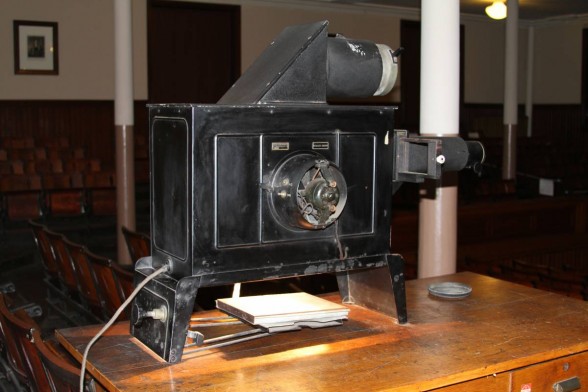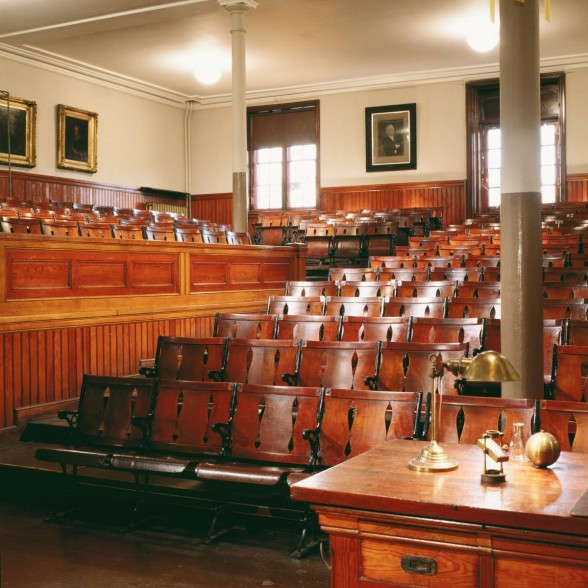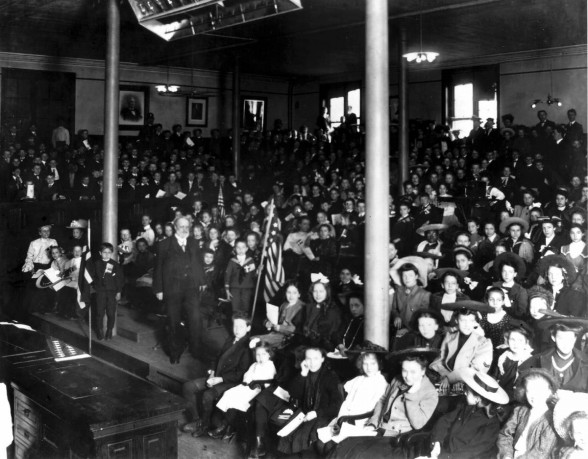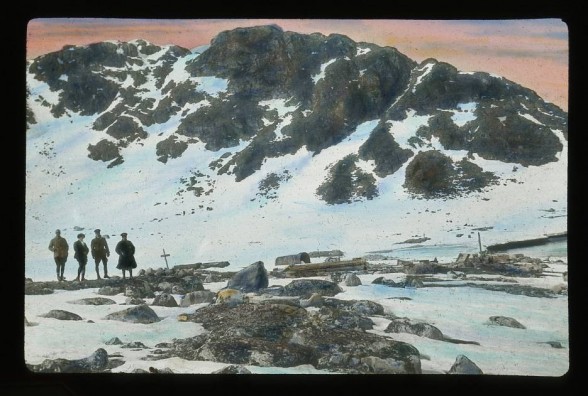[Michael travels back in time through slides of Philadelphia and beyond, glimpsing the history that lies beneath our familiar cityscape and discovering a rich trove of knowledge available to anyone. — the Artblog editors]
On Oct. 8, as part of Archives Month Philly, the Wagner Free Institute of Science held its 2nd Annual Philadelphia Lantern Slide Salon, which showcased an assortment of antique glass slides from the collections of six amazing historical collections in town. This awe-inspiring event took place in Wagner’s Victorian lecture hall, where visitors were sent back into the 19th and 20th centuries to visit historic Philadelphia, lavish gardens in the Italian countryside, and the frigid glaciers of the North Pole.
Old-school technology in a historic setting

The evening began with a brief history of glass slides–a photographic process developed for image projections on The Magic Lantern in Philadelphia during the 1840s by William and Frederick Langenheim. Then, the lights were dimmed and the electronic 1914 glass slide projector was warmed up for five 15-minute presentations by each of the contributing institutions. A low hum occupied the lecture hall as anxious history enthusiasts held their breath, only to be interrupted by the sound of a metal drawer that would screech open and closed with every newly loaded glass slide.

Nurses’ impact on patient treatment
The Barbara Bates Center for the Study of the History of Nursing kicked off the night with an assortment of pictures of hospital wings and historical portraits of nurses in Philadelphia and abroad. As the presentation continued on, and I sat among the taxidermy animals, skeletons, and assorted pictures on the walls of the Victorian lecture hall, I could not help but feel as though I had been transported to the 19th century to attend one of the Wagner’s free science lectures.

An overarching educational drive permeated the night’s presentations, especially the one by the Barbara Bates Center, which advocates for the importance of nursing education and its development into a modern practice. They achieved this by pairing their hospital-wing-laden slides with a supplemental oration on the early history of nursing. As the slides progressed further into the 20th century, the number of nurses in the images increased, suggesting that the grandeur and efficiency of the hospital’s patient treatment, presented in the pictures, was a result of the nurses’ aid.

Lush gardens and travel photography
Following the Barbara Bates Center’s presentation, the Philadelphia Museum of Art illuminated the industrial roots of the museum’s history–founded one year after the United States’ first World’s Fair in 1876 as the Pennsylvania Museum and School of Industrial Art–that gave way to an interest in the “fine arts” with Anna H. Wilstach’s donation of her personal collection in 1893. The museum’s collection swelled with an assortment of artifacts, design objects, paintings, sculptures, etc., and led to the construction and completion of the museum’s current building, on the Ben Franklin Parkway, in 1928.
Perhaps the most stunning images presented by the PMA were those from the Works Progress Administration-funded pursuits under director Fiske Kimball (1925-1955), during which time he helped to establish the institution’s archive and to commence early cataloguing efforts that are used today.

My personal favorite presentation came from the McLean Library of the Pennsylvania Horticultural Society, which presented gorgeous hand-colored glass slides of historic gardens, such as the “Iris Bowl” garden on the Lloyd Estate in Haverford, PA, and Stella Elkins Tyler’s extravagant garden (the founder, with Boris Blai, of Temple’s Tyler School of Art). The piece de resistance of the PHS’s presentation was a series of travel glass slides distributed by the Fratelli Alinari–the world’s oldest photography company, founded in 1852 in Florence, Italy–that included views of Tivoli’s waterfalls from 1890 and assorted scenes of Italy’s vast gardens and cities.

The Athenaeum of Philadelphia chronicled the development of the Independence Mall complex in Philadelphia with a unique view of the restoration process of the Signing Room in Independence Hall. Surprisingly enough, the Athenaeum included a picture of the Signing Room at a time when the Liberty Bell was housed between the two fireplaces in the room, revealing a fact that I had not previously known.
The entertaining, fast-paced insight into neighborhoods and sights across Philadelphia was the real highlight of the lecture. Most locals have seen in passing or visited places like Independence Hall, but to see them chronicled over time in these old slides was a revelation. For example, the Historical Society of Frankford displayed a series of historical monuments along Frankford Avenue, many of which are no longer recognizable from the street, after years of construction.
Adventure, disaster, and a yearning to learn more

By far, the most engaging and comprehensively researched presentation came from the Historical Society of Pennsylvania–a vivid narrative told through a series of hand-colored glass slides, some of which were cracked or exhibited signs of wear, depicting the aftermath of the ill-fated journey of the Airship Italia, a blimp-like airship that crashed on a trip to the North Pole in 1928. That much is known about the ship’s voyage; however, the Historical Society of Pennsylvania’s talk speculated on the events that occurred in the 49 days after the crash, which resulted in the loss of half of the airship’s crew.
By the time the Historical Society of Pennsylvania finished presenting their research, I wanted to see more from each of the contributing institutions. The range of diverse imagery presented was not only impressive, but also shocking because it pointed to the immense number of resources in Philadelphia that are easily accessible to the public. Like the institutions involved, Archives Month Philly provides many stimulating events and opportunities like this one, and is itself a wonderful resource.
For more information on Archives Philly Month’s other events, check out its website. And check out the websites of all the participating institutions: the Athenaeum of Philadelphia, The Barbara Bates Center for the Study of the History of Nursing, the Historical Society of Frankford, the Historical Society of Pennsylvania, the McLean Library of the Pennsylvania Horticultural Society and the Philadelphia Museum of Art.









